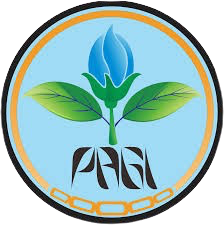Effect of KNO3 Concentration and Fruit Maturity Levelon the Viability of Papaya Seed (Carica papayaL.) cv.Callina
DOI:
https://doi.org/10.22219/jtcst.v2i1.10624Keywords:
KNO3, fruit maturity, seed viability, germination rateAbstract
The research was aimed to examine the effect of different concentration of KNO3 and fruit maturity level on the seed viability of papaya. This research used Completely Randomized Design (CRD) factorial with two main treatments. The first treatment was fruit maturity level (A0: 75% dan A1: 100%). The second treatment was concentration of KNO3 (B1 = 0 M ; B2 = 0,05 M ; B3 = 0,1 M ; B4 = 0,15 M ; B5 = 0,2 M). Seedling parameters observed were germination rate, seed growth rate, vigour index, and maximum growth potential. Nursery parameters observed were plant height and leaf area. Data were analyzed with Analysis of Variance (ANOVA) followed by Duncan Multiple Range Test (DMRT) at 5%. The interaction between fruit maturity and KNO3 concentration showed significantly in germination rate, seed growth rate, vigour index, maximum growth potential and plant height. Leaf area were only
affected by KNO3 concentration. This showed that fruit maturity level and KNO3 concentration were significantly affects seed viability.
Downloads
References
Ardi .D.T., Haryati., dan J. Ginting. Pemberian KNO3 dan air kelapa pada uji viabilitas benih pepaya (Carica papaya L.). J. Agrotek. 6 (4) : 730 – 737.
Astari R.P., Rosmayati., dan E.S. Bayu. Pengaruh pematahan dormansi secara fisik dan kimia terhadap kemampuan berkecambah benih mucuna (Mucuna bracteata D.C). J.O. Agrotek. 2 (2) : 803 – 812.
Direktorat Jendral Hortikultura. 2016. Laporan Kinerja Direktorat Jendral Hortikultura TA. 2016. Kementerian Pertanian Republik Indonesia Tahun 2017. Jakarta.
Hartawan, R. 2016. Skarifikasi dan KNO3 mematahkan dormansi serta meningkatkan viabilitas dan vigor benih aren (Arenga pinnata Merr.). J.M. Pert. 1(1): 1 – 10.
Juhanda., Y. Nurmiary., dan Erawati. 2013. Pengaruh skarifikasi pada pola imbibisi dan perkecambahan benih saga manis (Abruss precatorius L.). J. Agrotek Tropika. 1 (1) : 45-49.
Koheri., Anwar., Mariati., dan S. Toga. 2015. Tanggap pertumbuhan dan produksi bawang merah (Allium ascalonicum L.) terhadap waktu aplikasi dan konsentrasi pupuk KNO3. J. Agro. 3(1) : 206 – 213.
Melo. L.D. F.D.A., L. D. P. Rezende., V. M. Ferreira. J. C. D. A. Neto., V. S. G. D. Silva., R. D. A. Paes., L. F. G. Chaves., P. C. Souto. R. J. N. D. Silva. 2019. Physiological maturation and postharvest resting of papaya fruits and seeds in agroecological transition. A. J. O. Crop Science. 13 (06) : 955 – 1000.
Murniati, E., M. Sari., dan E. Fatimah. 2008. Pengaruh pemeraman buah dan periode simpan terhadap viabilitas benih pepaya (Carica papaya L.). Bul. Agron. 36 (2) : 139 – 145.
Saputra. D., E. Zuhry., dan S. Yoseva. Pematahan dormansi benih kelapa sawit (Elais Guineensis Jacq.) dengan berbagai konsentrasi kalium nitrat (KNO3) dan pengaruhnya terhadap pertumbuhan bibit pada tahap prenursery. JOM. Faperta. 4 (2) :1-15.
Sari. M., M. R. Suhartanto, dan E. Muniati. 2007. Pengaruh sarcotesta dan kadar air benih terhdap kandungan total fenol dan daya simpan benih pepaya (Carica papaya L.). Bul Agron. 35 (1) : 44-49.
Downloads
Published
How to Cite
Issue
Section
License
Copyright (c) 2020 Pamungkas et al.

This work is licensed under a Creative Commons Attribution-ShareAlike 4.0 International License.
Authors who publish with this journal agree to the following terms:
- Authors retain copyright and grant the journal right of first publication with the work simultaneously licensed under a Creative Commons Attribution License that allows others to share the work with an acknowledgement of the work's authorship and initial publication in this journal.
- Authors are able to enter into separate, additional contractual arrangements for the non-exclusive distribution of the journal's published version of the work (e.g., post it to an institutional repository or publish it in a book), with an acknowledgement of its initial publication in this journal.
- Authors are permitted and encouraged to post their work online (e.g., in institutional repositories or on their website) prior to and during the submission process, as it can lead to productive exchanges, as well as earlier and greater citation of published work (See The Effect of Open Access).











